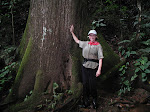This is a picture of me, Marj, Natasha and Lorena, just
arriving at the British Charity Picnic in Santa Ana. The British community raises funds at this
annual event, and all proceeds go to Costa Rican schools and clinics, as well
as to the Red Cross. We had just harvested
a slew of mangos at the Finca, so I made and donated jars of Mango Chutney for
the charity sale. However, I also had to
stock up on my favorite Brit foods:
Branston Pickle and Picallili.
Natasha rode a pony at the Picnic. Until recent years, the British Ambassador
always hosted the event in the Residence - Georgina Butler began the tradition
with a group of dedicated British volunteers - but I found that this year,
everybody loved the parking and ambience at Zamora Estates in Santa Ana. We behaved like kids again all morning and
then, when the kids hit the swimming pool, the adults congregated around the
Pimms Bar, Silent Auction, Penny’s Used Books, back to the Pimms Bar…
You can’t just walk past this flower! Isn’t Hylocereus
costaricensis absolutely gorgeous? First
of all, you can only see the night-blooming flowers of the Hylocereus (local name Pitahaya) cactus at dawn. I took the photo of this plant at
5:30AM. The huge, trumpet-shaped,
fragrant flower starts budding at dusk, and then blooms all night long until
about 6AM. By 9AM, the flowering show is
over. This photo is unusual because you
can see the flower’s center in full bloom, with stingless bees pollinating it –
note the numerous petals and stamens; finished flowers from the night before on
the right; and a developing fuchsia/magenta-colored pitahaya fruit on the
left. When ripe, you pick the pitahayas
(before the monkeys get them), slice them in half, scoop out the delicious
magenta fruit in the center and eat it all!
This is best done alone else you will have to share! Perhaps we shall have three pitaya fruits at
once and then I can invite over a friend or two for a special feast!
Here’s a shot of Danny standing with the blooming Pitahaya
cactus flower. We took this picture at
about 7:30AM and the show was over by breakfast. The mostly epiphytic Hylocereus grows on
trees and can really bunch up together, as this one did on a big tree stump
located just outside the house at the edge of the forest. It seems to grow easily here in the Zona
Protectora El Rodeo, and some people cultivate it to sell for making
ice-cream. There is just nothing quite
like it – delicious.
Just by pure coincidence, I saw a forest sloth just outside
the house the other day, along with a bunch of cavorting monkeys. The capuchin monkeys visit all the time to
raid the orchards – the dogs ignore them and I rather enjoy observing the
monkeys as they surreptitiously observe me.
So, at first I thought the big creamy creature lounging amongst the
monkeys in the forest was just a mature, male capuchin. The juvenile monkeys playing nearby always
leave a large berth around grumpy old males.
But then I looked again, and then got out the binoculars and really
looked! It was a sloth! I’d never seen capuchins together with a
sloth before and wondered how they would behave. In fact, they just ignored each other! Even though the monkeys knew full well that
the sloth was lounging and munching on a cecropia tree, they jumped and played
together all around him, jumping from tree branch to branch very close by, but
completely ignoring him. I guess the
monkeys sensed that the sloth was neither prey nor predator, so was not worthy
of further attention; kind of like the human sitting down there on the
terrace. Not worth another second’s
thought… The monkeys often come up and
sleep on trees near the house – perhaps they perceive the house as offering a
kind of security from predators, but I’m not sure. Next morning, they are always gone and this
was true again. And the sloth left
too. They’re not that slow when they
want to relocate!
All of Costa Rica is still reeling over the murder of conservationist
and turtle guardian Jairo Mora. I truly
believe there are more good people on this planet than bad but, at times, the
good people have to pull together and hit hard.
And this time we must hit hard the thugs and criminals who rob turtle
nests and kill, in cold-blood, dedicated and brave protectors of nature; we
must not let them get away with murder!
This has happened in the past in Costa Rica, and I join all the voices here
and around the world: “Capture and
prosecute these thugs to the full extent of the law!” Let’s walk the walk Costa Rica!








